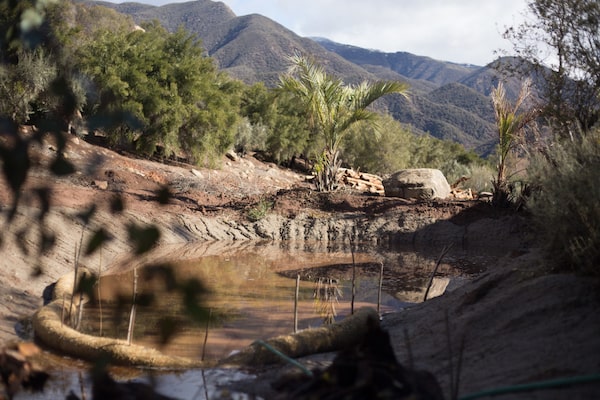
East End Eden's Connor Jones says the idea for a permaculture education site literally hit him on the head when a book about permaculture fell on him in high school.
Even while watching the massive wildfires rage near to home and along the west coast of North America, Connor Jones and Misha Morris kept their eyes on Eden.
The men are committed to East End Eden, a 10-acre farm in Ojai, Calif., devoted to permaculture techniques.
“Permaculture is about designing a habitat for human beings,” says Mr. Jones, 26, who has worked on the farm and its demonstration projects after studying permaculture in Australia.
“We’ve been doing this since we were kids out of high school,” says Mr. Morris, 23, a transplanted Canadian who moved here from Toronto when he was four years old. “It’s a process based on observation. We’re watching natural patterns and mimicking them.”
Mr. Jones adds, “We feel this kind of agricultural management is the only way that people can survive. There are only enough resources if we try to regenerate them."
Permaculture is an all-encompassing concept, but basically, it is a form of agriculture and design that aims to imitate as much as possible the patterns of natural ecosystems. For instance, farming that nourishes rather than depletes the soil, water conservation that uses techniques to save rainwater and mountain ice melts, rather than allowing this to wash to the sea, are all aspects of permaculture.
This is what East End Eden seeks to emulate, through demonstration projects and by running courses for farmers and aspiring growers.

East End Eden's Connor Jones: 'We have ponds that we’re proud of. The newest pond at East End Eden is so large that when everyone is talking about drought we’re playing in the water.'
“I get some inspiration from Ontario – most of my family is there and I spent my summers in Algonquin Park. The water and the forests there are still amazing. It’s a hugely different ecosystem there, but the principles of protecting it are the same,” says Mr. Morris, who works as a consultant to the farm.
The roots of permaculture, in fact, go back thousands of years. The Nabateans in the ancient Middle East developed farming by collecting runoff water, using terraces, channels and cisterns that could concentrate water from an area five times larger than it would normally drain. And Indigenous cultures have practised sustainable land use globally.
Mr. Jones, Mr. Morris and their colleagues at East End Eden believe that adapting some of these practices to modern-day agriculture make sense in an area such as southern California, which, like the Mideast, can be susceptible to droughts and then sudden floods.
They have contoured the landscape using permaculture principles to build ponds that can conserve water that would otherwise wash away.
“We have ponds that we’re proud of. The newest pond at East End Eden is so large that when everyone is talking about drought, we’re playing in the water,” Mr. Jones says.
Both men stress that permaculture doesn’t mean leaving nature untouched, it means working with principles found in nature to shape the land, water, forests and fields.
For instance, spraying an orchard with pesticides would not be permaculture. But developing a field with culverts and channels to protect water and with a mixture of species to preserve animals and plants that control pests would be consistent with permaculture principles.
Sometimes that means reshaping the landscape, to be more consistent with the larger environment in the region, Mr. Jones says.
As for the wildfire problem of recent years, which many experts blame on climate change, forest management and development, some permaculture responses can include controlled burns and managing the physical landscape, according to the Australia-based Permaculture Research Institute. But the possible solutions really vary across the different conditions of each area.
In the past decade or so, there has been growing interest in permaculture in Canada, with some level of permaculture activity in most Canadian provinces, according to B.C.-based The Urban Farmer.

A goat on East End Eden farm.
The big ideas about permaculture were advanced by two academics in Tasmania, Bill Mollison and David Holmgren in the 1970s. In their 1978 book, Permaculture One, and in subsequent work, they advocated sustainable practices that include organic farming, protecting biodiversity and conserving topsoil.
The Permaculture Research Institute in New South Wales, Australia, which Mr. Mollison founded, runs the certification program that Mr. Jones completed. East End Eden runs introductory workshops and specialized programs on how to preserve food, gather water, protect soil and manage livestock using permaculture principles.
“We’re not a commercial farm – we don’t normally sell products. Our primary source of revenue at the farm is from education. We’ve had people take our courses from all over the United States and Canada,” Mr. Jones says.
In operation since 2008, East End Eden is Mr. Jones’s family farm, and he says the idea for a permaculture education site literally hit him on the head.
“I had no plans. I was in an algebra class in my senior year of high school and I was bored,” he says.
“I was leaning back in my chair daydreaming and the chair gave out. I ended up hitting my head on the bookshelf. The first thing I saw was a green-spined book by Bill Mollison. It was Permaculture One.”
/arc-anglerfish-tgam-prod-tgam.s3.amazonaws.com/public/QXMABX322VECVM6VBTNHBRKHR4.JPG)
/arc-anglerfish-tgam-prod-tgam.s3.amazonaws.com/public/VEAKZRNPTZIJPLILEUEVIQJAZI.jpg)
/arc-anglerfish-tgam-prod-tgam.s3.amazonaws.com/public/LLT44SVELRCQ3MLPIRVP4NF43M.jpg)